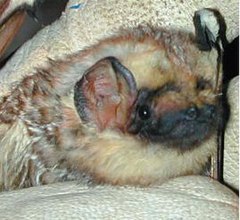Lasiurus
| Hairy-tailed bats | |
|---|---|
 |
|
| Lasiurus cinereus | |
| Scientific classification | |
| Kingdom: | Animalia |
| Phylum: | Chordata |
| Class: | Mammalia |
| Order: | Chiroptera |
| Family: | Vespertilionidae |
| Subfamily: | Vespertilioninae |
| Tribe: | Lasiurini |
| Genus: |
Lasiurus Gray, 1831 |
| Type species | |
|
Vespertilio borealis (Müller, 1776) |
|
| Species | |
|
See text |
|
See text
Lasiurus is the genus comprising hairy-tailed bats. The generic name Lasiurus is derived from the Greek lasios (hairy) and oura (tail). It contains some of the most attractive bats (Chiroptera) in the whole continent of North America, including such species as the eastern red bat, L. borealis, and the hoary bat, L. cinereus. They are very robust and long-winged, with fast and strong flight; several species fly during parts of the day, especially when migrating south in autumn. The hoary bat and red bat will often fly in daylight during winter.
When roosting, this group is also interesting as they hang from twigs, usually hidden by leaves in trees, and do not use caves. The northern species, such as the red and hoary bats, have particularly thick and dense fur for extra insulation, and may migrate south in winter, although winter roosting sites can still be quite cool.
They are, as a genus, unusual, being the only bats apart from the parti-coloured bat Vespertilio murinus to possess an extra pair of nipples (four in total). This allows them to suckle more than the usual one pup per season that most bats produce, with two or three being common and sometimes four produced, though more rarely.
...
Wikipedia
